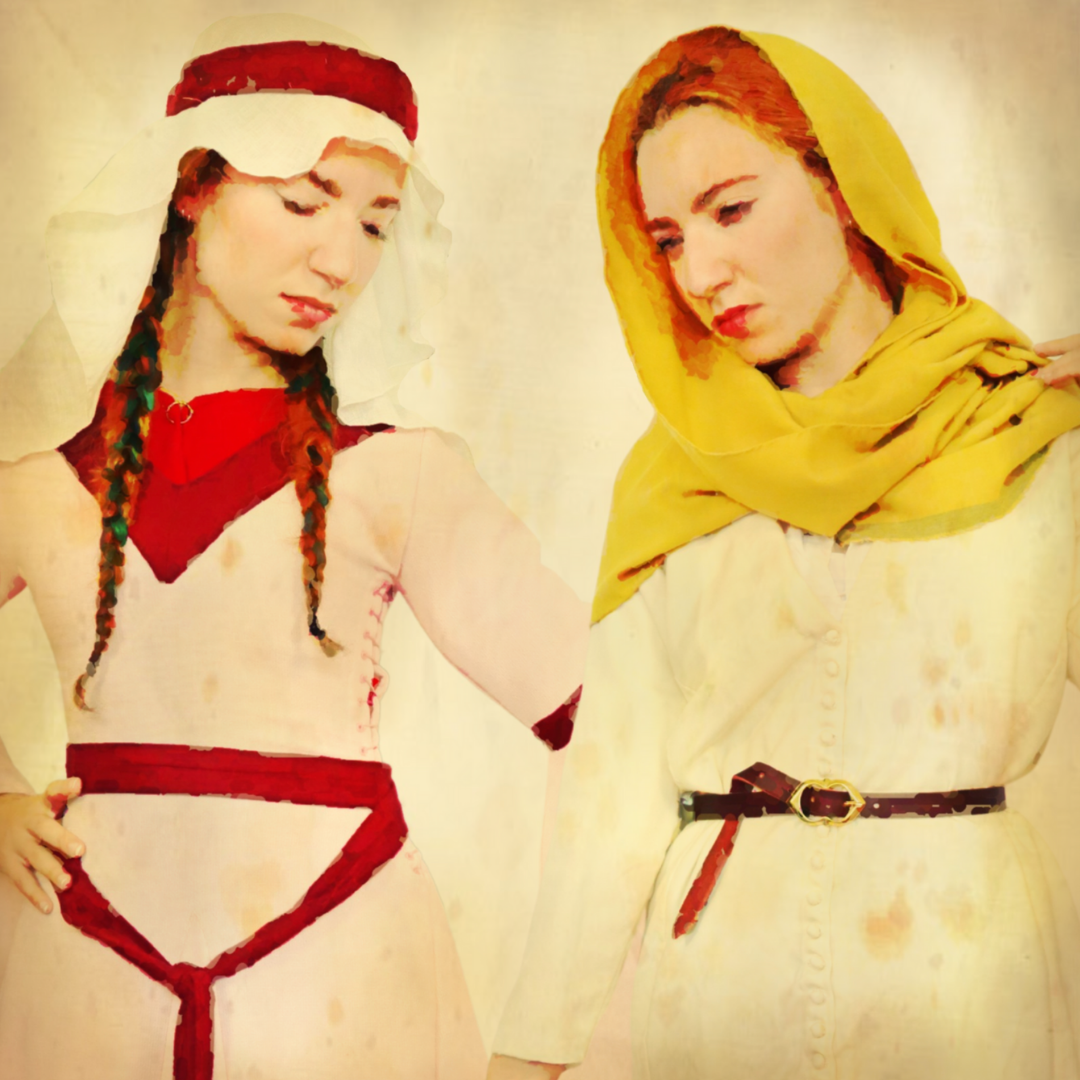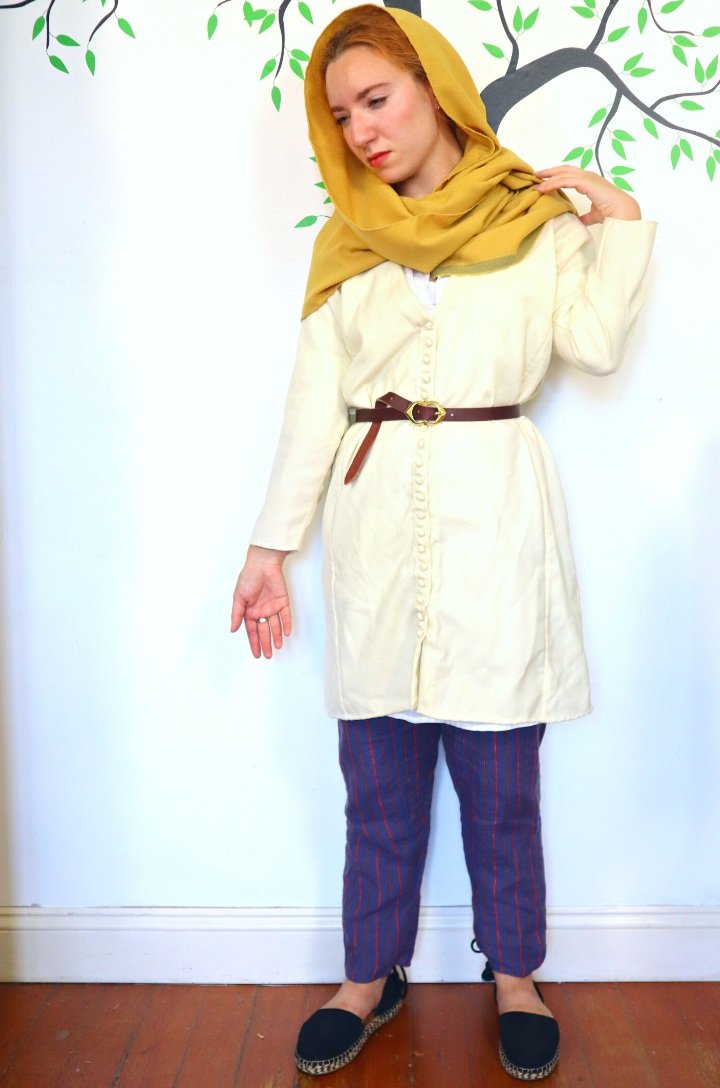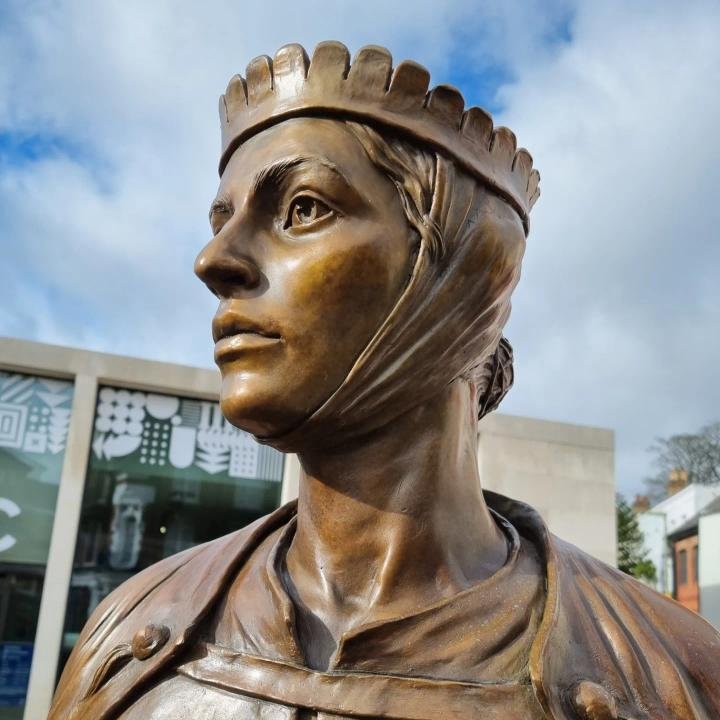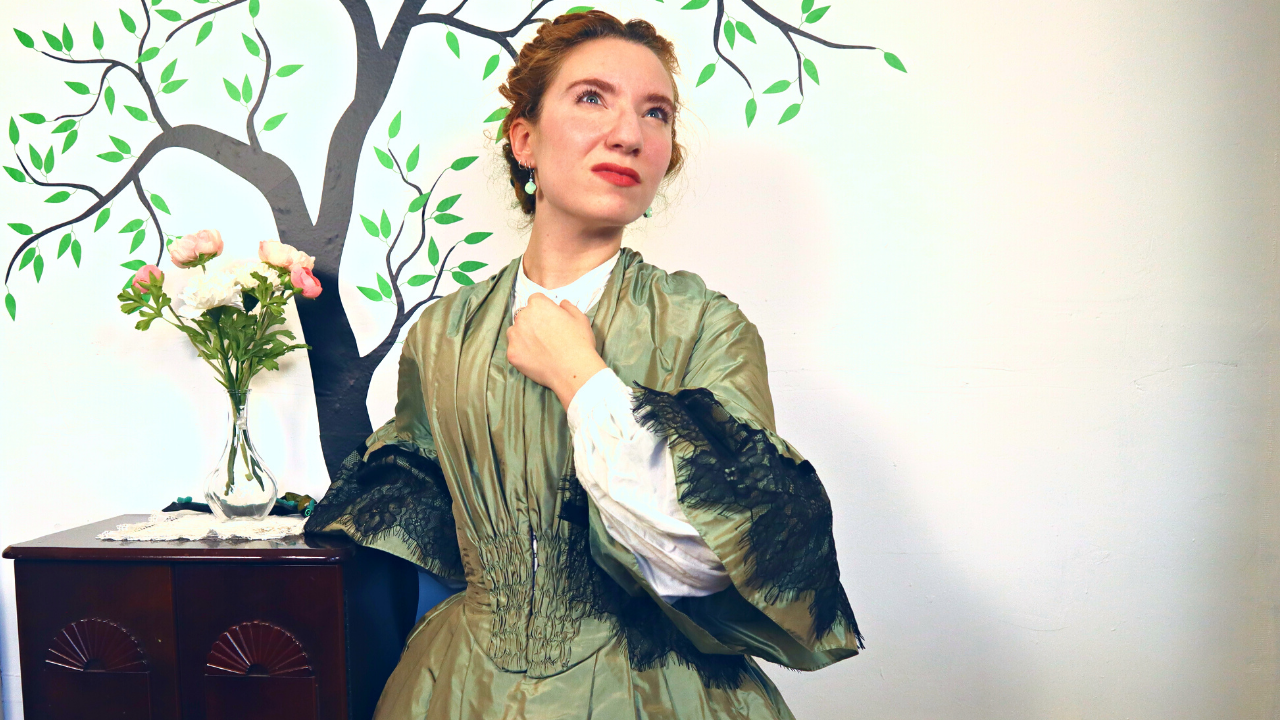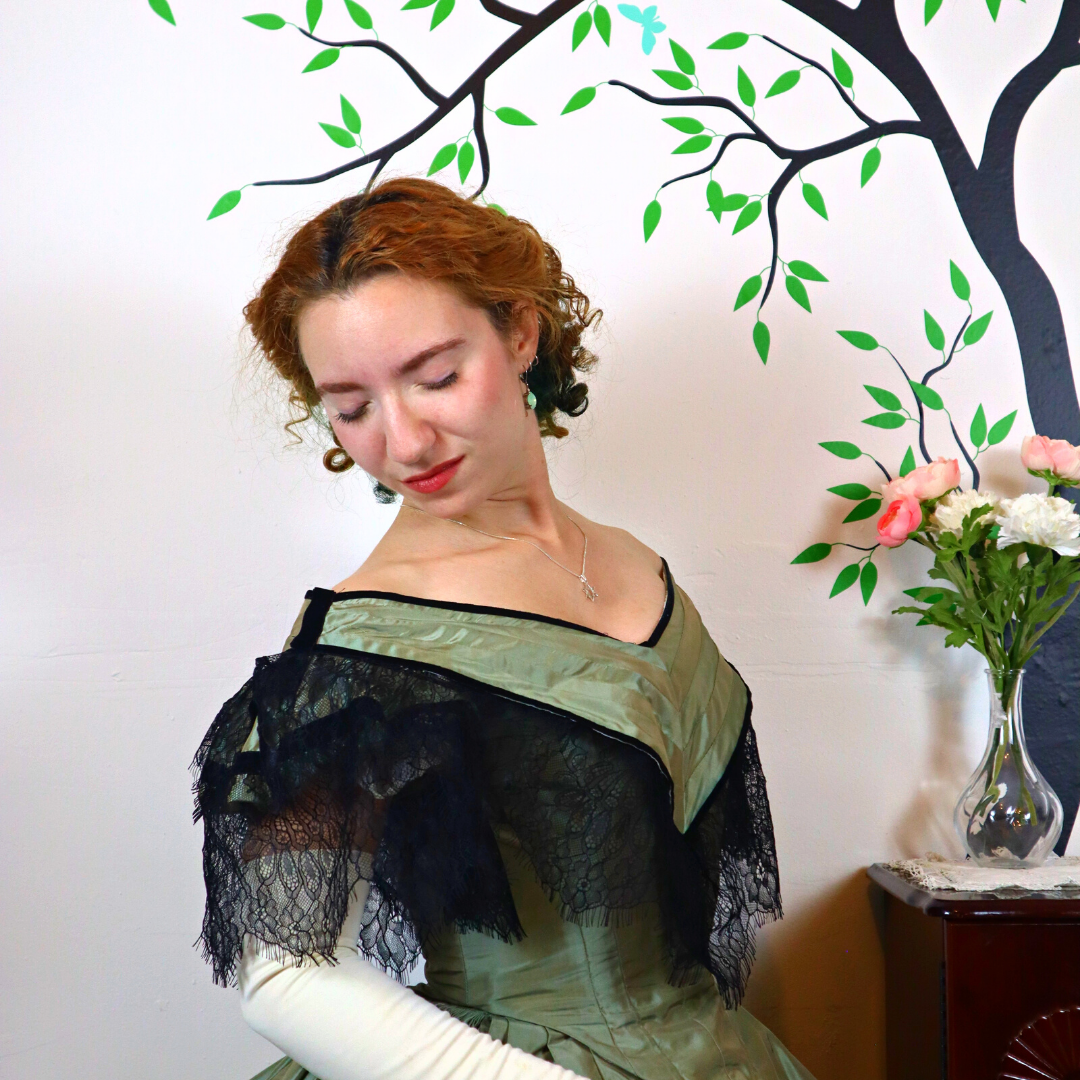Getting dressed in the middle ages, while Jewish
Getting dressed in the middle ages, while Jewish
How would a medieval Jew dress? Historical Jewish fashion varied, in England, and Spain, and everywhere else. It depended on when and where they lived, how well the Jewish community was treated, and that Jew's status within their community and the wider world. We'll take an in-depth look at the historical costumes of two 11th century Jewish women : An Ashkenazi Norman English Jew, and a Sephardic Jew living in Islamic-ruled Iberia (present-day Spain).
How medieval Jews dressed differently
In the middle ages, Jews lived all over Europe, as well as throughout much of Africa and Asia. Their historical fashions varied just as much as those of their non-Jewish neighbors. Jewish traditional dress might be completely different from the non-Jews of the same region, especially if the Jewish community was separate, or it might be look identical on the surface, with only small differences in construction. Jewish tailors and dressmakers would have sewn their clothes differently due to a religious prohibition on wearing "sha'atnez", wool and linen in the same garment.
the English outfit
A high-status Norman English Jew, either invited to move to England by William the Conqueror or perhaps the first generation born on English soil, would have looked much like anyone else on the surface. Her outfit would consist of the same linen smock and wool outer layers as other English people's, but since her wool clothes couldn't be sewn with linen thread they would have to be made differently. If she is a person of status in a formal setting, she wears a bliaut, a shaped overgown with a dramatic silhouette that still influences fantasy costume today. You can see the making of this gown here.
the Spanish outfit
An Iberian Jew living in Al-Andalus as a "dhimmi" (protected, second-class non-Muslim citizen) would dress completely differently from our image of medieval Europe. Both a warmer climate and Islamic cultural norms allow for a base layer of sheer linen or even cotton, and both underpants and trousers could be worn by people of any gender! In an informal private setting, no other layers would be necessary. For going out, an additional layer is added in the form of a button-front lightweight wool coat. Jews in Islamic territories wore identifying dress as one of the conditions of their protected legal status, which most often took the form of yellow or honey-colored veils.
-
If you saw this outfit at a historical event . . . what would you assume about the person wearing it?
Is it medieval? Where is it from, and when?
Would you assume there's anything Jewish about the clothes?
Did it occur to you you might be looking at a medieval Jew?
What are the differences? Would it be okay to notice them?
Welcome to SnappyDragon Studios! I'm V : Costumer, history nerd, and unapologetic Loud Jewish Girl. Extra special welcome to everyone watching this during CoSy; go look in the description and the pinned comment for links to the full schedule!
Let me tell you a little about me . . . and in the process, about Jewish heritage in a nutshell. I'm American, of Ashkenazi heritage, raised in a very hippie Reform community, I'm agnostic and practice my Judaism culturally. We'll break all that down for the goyim— first, "goyim" means "non-Jews" and has no negative connotations. There are many different cultural heritages within Judaism. In this video I'll be talking about Ashkenazi Jews who descend from Jewish communities in Eastern and Central Europe, and Sephardic Jews who descend from the Spanish and Portuguese Jewish community that was expelled around 1492. However, there are many many more, including Jewish communities from Ethiopia, Yemen, India, Italy, Central Asia, the Caucasus, Georgia, Greece . . . There are Jews of all races living everywhere in the world from all sorts of heritages. In the modern world there are also "sects" within Judaism, although these sort of codified differences didn't exist in the middle ages. The most commonly known today are the Orthodox, Conservative, and Reform sects, but there are several others. I grew up Reform, so that's what I know most about. It grew out of a desire in the 18th and 19th centuries for Ashkenazi Jews in Western Europe and America, to assimilate into Christian-normative or "secular" society, to have greater safety and freedom. A lot of Reform Jews live very secular or secular-seeming lives . . . Which segues nicely into being an agnostic and "cultural" Jew : Jews are known for having incredibly diverse and conflicting beliefs about everything, *especially* Judaism itself, to the point where "ask two Jews, get three opinions" is a common saying. Since Judaism occupies this interesting space where it's a religion *and* a culture *and* sort of an ethnicity, many Jews identify strongly with the cultural components even if they are atheist, agnostic, and/or not spiritual or religious. There's some further reading in the description.
Now, especially in Western media, the usual idea of what a Jew is, is . . . basically, me. White, Ashkenazi, from the Northeast US. This is *not* a particularly accurate idea, and like I said, there are Jews of all races and all cultures living all over the world. All this to say : My perspective is limited on account of me being one person, and is also affected by the fact that I happen to line up with the wider world's incorrect perceptions of the Jewish people. The Jewish experience is so broad and diverse and varied, it would be impossible for me to represent or talk about all of it because there's just too much there. So I'm going to zoom in on two settings that I have studied a bit more : England and Spain, both in the late 11th century.
The further back you go in history, the more distinct cultural styles of dress you'll find among all sorts of groups. In that regard, Jews and the cultures within Judaism are no different. Especially within separated Jewish communities, you might see clothes that were very different from what goyim living in the same area wore. However, many historical Jewish communities were intermingled with goyish society, and those Jews may have dressed more according to their local cultural styles. As a general rule, the more that Jews were accepted or assimilated into goyish society, the more like their goyish neighbors they would dress. The flip side is that goyish society often required Jews to wear "identifying dress", different clothes so everyone who saw them knew they were Jewish, as a way of enforcing separation between Jews and everyone else. Obviously this is a very antisemitic practice, and the first kind of identifying dress most people will think of is from 1930s and 40s. But the practice has existed for well upwards of a thousand years. In the 11th and 12th centuries there were actually no blanket "sumptuary laws", meaning restrictions on clothing according your rank or property or income, in either England or Andalusian Spain. While these laws were a major factor in Jewish and goyish dress in other settings, I won't be getting into them because they didn't exist in the areas we're looking at right now.
However, there was one major cultural difference that affected Jewish dress right down to the construction methods, and it's called sha'atnez. The Torah prohibits wearing "wool and linen together". Shoshi of Costume Literate is a bit of an expert on sha'atnez and has a video that's just come out about it, so go watch it and subscribe to her channel! She was *incredibly* helpful with the research for this video.
Jewish scholars have, very characteristically, argued a great deal about what exactly this means, whether it applies to only fabric like linsey-woolsey, or having both linen and wool fabrics in one garment . . . The general historical and modern interpretation is that while it's okay to wear separate garments of wool and linen at the same time, you couldn't have wool and linen in the same garment in any capacity. This is a big deal because a lot of Western Europe was sewing wool garments together with linen thread. Jewish tailors and wearers would have needed different construction methods and been very careful of their fiber usage. I have a lot more research I want to do on what these construction methods actually were, and I've run into some materials-related challenges in replicating them. If you have any sources for wool sewing thread, *please* put them in the comments.
We'll be looking at two outfits : An English Ashkenazi Jew from the late 11th or early 12th century, and a Sephardic Jew living in Muslim-ruled Andalusia or present-day Spain, at the same time. Neither of these outfits is a perfect historical reconstruction, if such a thing could even exist, and each will be the focus of its own in-depth sewing and research video coming out after CoSy! Subscribe so you don't miss those.
Around 1070 in England, William the Conqueror extended a welcome for Jews from his home of Normandy to come to England. They primarily settled in towns and cities, with Oxford being one of the first. Jews brought with them trade connections to Jewish merchants around the Mediterranean, which were so desirable that there are records of Bishops elsewhere in Europe establishing legally protected Jewish communities to make their towns more prosperous. Under English feudal law, Jews were considered "royal serfs" and subject directly to the Crown. They had the right to hold land from the monarch, to move freely within England, to buy and sell, and to swear on the Torah when a Christian would use the Bible. Many were successful tradespeople, merchants, tutors, property owners, and yes— moneylenders. The antisemitic myth about Jews being money-hungry came from Christians pushing Jews into financial work because they themselves were barred from doing it, then vilifying us for doing work that was contrary to their religion but necessary to their society. William the Conqueror preferred to receive his feudal dues in coin directly to the treasury, so there was a huge need for moneylenders in the kingdom.
My first layer is a linen smock, which serves as my base layer or "underwear". Linen is easy to wash, comfortable, and kept the body and the outer clothes cleaner when worn between them. This smock has a keyhole neckline, long sleeves with square gussets under the arm for movement, and an ankle-length skirt with gores in the sides. It's sewn with waxed linen thread, mostly unbleached gray, but a little bit of bleached white at the neckline. On my legs and feet, I have bias-cut woven hose in gray linen— wool would be the accurate choice, but I live in California and I'd rather not overheat. Sha'atnez can apply to things like garters and belts, since your hose depend on your garters to stay up, so I've used linen tape garters tied just below the knee instead of wool. The shoes are not accurate, they're just what I have around.
Next comes a wool kirtle, with a similar cut to the smock, but gores in the front and back as well as the sides. There's again a high keyhole neckline, which closes with a brooch. Since wearing fully separate garments of wool and linen at the same time was not considered sha'atnez, I can wear this over my linen smock. What would be a problem is the fact that this kirtle is actually sewn with linen thread, which *is* sha'atnez. Sorry! It's doing double-duty from a Viking-age outfit.
If I add a leather belt, this would be a complete outfit for working dress, or informal wear. But remember how I talked about the prosperity and success of the Jewish community? Let's add a gown over this kirtle, an extra layer worn for formal dress or by those who could afford the expense of more fabric.
This is a "bliaut", a fashion brought in by the Normans during the conquest, which could perhaps be more familiar to Norman Jews who emigrated to England than it was to the local English. It's made in pink wool, with a wide gored skirt and huge draping sleeves, and lacing at both sides to create a close-fitting naturally curved silhouette. To make this gown suitable for a Jewish wearer, the eyelets are bound in wool yarn rather than linen thread, and the lacing cord is also made from wool. The sides of the gown are spiral-laced using a metal aglet sewn to the lacing cord. This pulls the gown close to the body, showing off the wearer's figure, and the fact that they could afford a garment fitted with curves, which required fabric waste to cut. Cloth was extremely expensive to produce, so this was a pretty big deal.
Around my waist I'll tie a wool girdle, matching the contrasting wool trim at the neckline. Goyish fashionable hairstyles during this period involved partially uncovered hair even for married women, which was a bit of a departure from the wrapped veils of the previous period or the wimples of the following one. There's a tradition of married Jewish women covering all of their hair which continues into the modern day, depending on how observant a person is. It's not a commandment or law from the Torah, rather it's a cultural norm that became a religious rule. It has its roots in social customs stretching back millennia, where married women of all sorts of religions were expected to cover their hair. I am not married, so my hair is in two braids, with a circular linen veil draped on top of my head and kept in place by a wool band and some pins. If I were married, I might pin or tape my braids to my head, and wrap my hair in a kerchief or wear a cap under my veil to cover everything.
Around the same time, but at the southern end of Western Europe, there was a massive Jewish community in present-day Spain and Portugal. The Iberian peninsula or Al-Andalus was mostly ruled by Muslim rulers in the 11th century, and it was one of the best places to be if you were Jewish. Muslim rulers in Iberia and Southwest Asia treated the Jews and other non-Muslims in their territories as "dhimmis", which was a protected legal status that didn't have any equivalent in most Christian territories. There were legal codes governing dhimmis, which did require deference to Muslims, an additional tax, and identifying dress, but in exchange for this they were otherwise treated as citizens rather than outcasts. Al-Andalus was also known for being more cosmopolitan and tolerant than other Muslim states, with records of Muslim women going without veils even though it was a cultural and religious requirement elsewhere. This comparative level of tolerance meant that many Jews rose to high rank, even at the courts of Muslim rulers.
My base layer for this outfit is a linen "qamis", meaning shirt, in a finer and lighter-weight linen to suit the warm climate. It's just above knee-length, and is a slightly different rectangular cut, with gores starting under the arms instead of at the waist. The neckline is high and round, but slit down to the sternum and closes with ties made of linen fingerloop braid. Under that, I am wearing pants! "Sarwal" trousers were worn by people of all genders in the Muslim-ruled medieval world, either as undergarments or outerwear. These have a rectangular cut with gores to add fullness in the leg, and fasten with a drawstring around the waist. Undergarment sarwal could be bleached linen or cotton, and might have an even simpler cut with short wide legs and no gores. Al-Andalus had greater access to a lot of the raw materials needed for rich textiles than the rest of Europe, including silk, cotton, and dyes like indigo. Linen dyes particularly well with indigo, so this striped deep blue linen is perfect.
If I wasn't going out, this would actually be a complete outfit for informal wear. The Muslim cultural norms in Andalusia allowed for wearing only these lightweight garments in private, informal settings, because of the hotter climate. Sometimes they could be fine cotton or silk, and quite sheer! And, yes, this outfit of sarwal and qamis is both the etymological and fashion cousin of Indian salwar kameez, by way of Persian and Arabic language and culture. In the rest of Western Europe, this would be considered underwear.
If I'm going anywhere, or doing anything more formal, I'll need another layer. First, I'll tuck my qamis into my sarwal, because it'll work better for this particular outfit. A common outer layer was a "jubba", a long gown cut exactly like the qamis. That wouldn't be suitable for this outfit's intended purpose, so mine is a "qaba", a button-front knee-length coat in lightweight wool. As best I can tell, the more layers you added the more formal the outfit was, so courtly dress might involve a jubba over the qamis, a heavy silk coat, and then a plain linen overcoat to protect the silk outdoors. The rectangular construction is similar to the qamis with a split down the front. I've sewn this with silk thread so it isn't sha'atnez. The material is a lightweight worsted wool flannel, opaque and light-colored to keep the sun off, but quite breathable so I won't overheat.
Now for the two items that make this outfit even more distinctly Jewish. My belt is leather, as required by the dhimmi laws. Rich fabric sashes were reserved for Muslims; Jews and Christians had to use other materials such as leather or cord. There may have been a specific style of belt that signified dhimmi status, but we don't seem to know what it looks like.
Dhimmis were also required to wear "honey-colored" or yellow headwear. Social norms around veiling were more lenient in Al-Andalus, so I have a simple stole or scarf made of lightweight yellow wool, hemmed with silk thread. If I were married I would probably cover my hair fully when out in public, but I am not, so draping a stole loosely around my head and shoulders will do. I haven't yet found any information on how hair was styled under the headwear, so it's in a single braid at the back of my head.
These two Jews, far apart as they were, might have been related. They could have been cousins, or in-laws, their families could have traded with eachother. Their lives would not have been perfect, or easy, or without discrimination, but they could have lived out their days in relative safety, with the freedom to prosper, to put down roots, and to live their lives as Jews.
It didn't last.
The first recorded blood libel in history happened in England, not even a hundred years after Jewish communities made their homes there. The Jews of Norwich were blamed for the unsolved death of a 12-year-old Christian boy— a boy who was made a saint. In Andalusia, the fall of the Umayyad Caliphate in the early 11th century led to political instability, which spelled danger for even the highest-ranking Spanish Jews. In 1066, the same year William the Conqueror came to England, at least 1,500 Jewish households were massacred in the city of Granada. Spanish Jews were endangered both by the Christian rulers' reconquest of the peninsula, and by the less tolerant Almoravids and Almohads who came to aid the Muslim rulers against the Christians. The Jewish philosopher Maimonides fled Muslim-ruled Spain in the mid-12th century. In 1290, after having taxed English Jews far beyond what they could pay, the English crown expelled every Jew from the country with only what they could carry, which freed the English upper classes from the debts they owed and allowed them to seize Jewish property. In 1492, less than a year after Christian rulers reconquered the whole Iberian peninsula, every Jew who had not been forcibly converted by the Spanish Inquisition was expelled. Jews were not legally allowed to live in England until 1656, and when they were, many of those that made the journey were the descendants of Sephardi Jews expelled from Spain a hundred and fifty years prior.
So when you think about Medieval Europe— and, much of Asia and Africa too— when you build your mental picture, your story about who was part of that world . . . Remember us. We were there. You might have known us at a glance, by a red apron or a yellow veil, or we might have looked like anyone else. We were there, and you will find us if you remember to look.
And if you can't find us . . . it isn't happenstance.
It's because we were erased.
Thank you for watching, and as always, I hope you learned something! And again, extra special thanks to my CoSy viewers. There are numerous playlists of CoSy content, which I'll toss a card for up in the corner, and a link to the full schedule including all the live panels, Instagram challenges, and Discord server invite is in the description. If you're watching after CoSy, you can still see all of the videos! Don't forget to like, subscribe, and leave me a comment about your favorite often-forgotten part of history. I'll see you in my next video . . . which, if it's still CoSy, will be on Saturday! Keep on learning, and keep looking for what's missing as well as what's already there. Bye~


